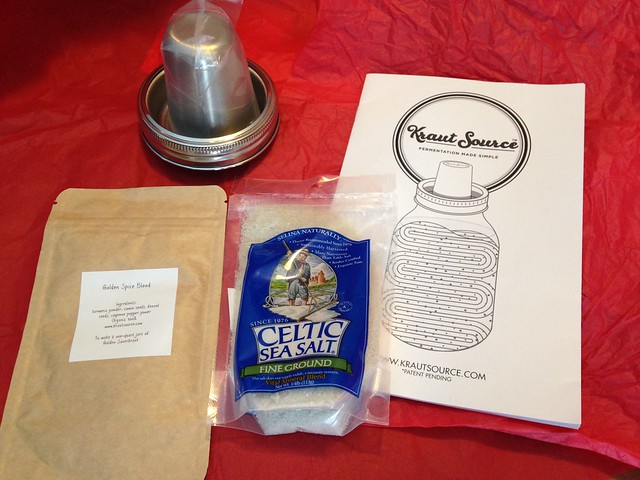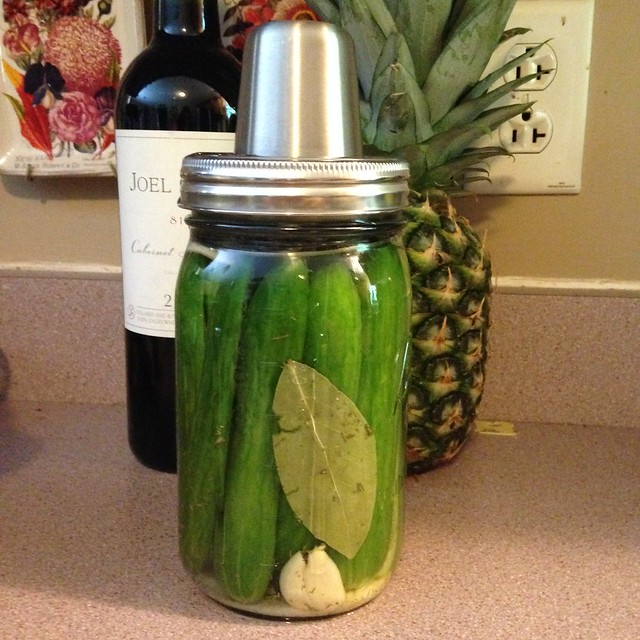There’s nothing like a good pickle. Am I right? A crunchy, tangy, sour pickle is the perfect companion to a lunchtime sandwich. I’ve made various types of pickles before — the quick-pickled “overnight” pickles and vinegar-brined pickles that were then canned for storage. But despite all of my attempts, none ever seemed to compare to the delicious Polish dill pickles my Babci used to make.
Ogórki kiszone (oh-GOORR-kee kee–
Back then I didn’t realize what the magic was, but I now know that it’s simply fermentation. So when my husband gave me a Kraut Source gadget for Valentine’s day, I knew that this summer I’d be making my own version of Babci’s pickles.
A couple weeks ago I finally decided to give it a shot. The batch took all of 10 minutes to put together, and the Kraut Source airlock lid was really easy to use. Could this possibly taste good? It’s way too easy, I thought. But I figured it was worth trying.
I set the jar on the counter and went about my business. A few days later, I checked on the pickles and started to worry. I had a few concerns.
- My fermented pickle brine looks cloudy. Is this normal? Is it supposed to look like that?
— After a little research I learned that the answer is YES! A cloudy brine is normal and is to be expected. It’s due to the growth of lactic acid bacteria and it’s a sign that fermentation is occurring. - There are white flakes or white specks at the bottom of my jar of fermented pickles. What is it? Are they still safe to eat?
— I was reassured to learn that the white bits are again, due to the lactic acid bacteria. Nothing needs to be done.
Whew! It was all going to be OK.
A week after I started the process, I decided to crack open the jar and have a family taste test. You understand, I live with some of the world’s most discriminating pickle connesiours. So you can only imagine my excitement when my husband and all three kids started fighting over pickle pieces and declared them “AMAZING!!!”
Hot damn, it worked! I’m not going to say that they were as good as my Babci’s, but they were definitely close.
Ogórki Kiszone (Polish Garlic Dill Pickles)
6-8 pickling cucumbers, washed and dried
4 cloves peeled, smashed garlic
1 stem dill with seeds (or 2 Tbsp. dried dill weed)
1 bay leaf
2-3 Tbsp. kosher salt, sea salt, or pickling salt (do not use table salt)
2 cups water
- Bring 2 cups of filtered water to a boil. Pour into a bowl and dissolve the salt. Allow the brine to cool completely.
- Trim the blossom ends off the cucumbers. (This helps them stay crunchy). You may leave the stem end on, if you like.
- Add the garlic, bay leaf, and dill to the bottom of a wide-mouthed quart-sized canning jar. Pack in the cucumbers.
- Cover the pickles with the cooled salt brine until it reaches about 1” above the shoulder of the mason jar. It is important that every bit of vegetable is covered with water, so trim the cukes down if necessary.
- If you have a KrautSource, follow the directions to secure it on the lid. If you don’t have the gadget, no problem. Loosely (may I stress loosely?) close the jar with a sterilized cap. Do not secure it tightly – the carbon dioxide that is produced during fermentation needs to escape.
- Store the jar out of direct heat (on the countertop should be fine) and check on your pickles every few days to make sure they’re still covered with water. After 7 days, your pickles should be ready to eat.
I can’t wait to experiment further with fermented pickles! For my first batch I used dried dill, but I know the flavor would be a lot better with fresh dill, so my next batch will definitely include it.



